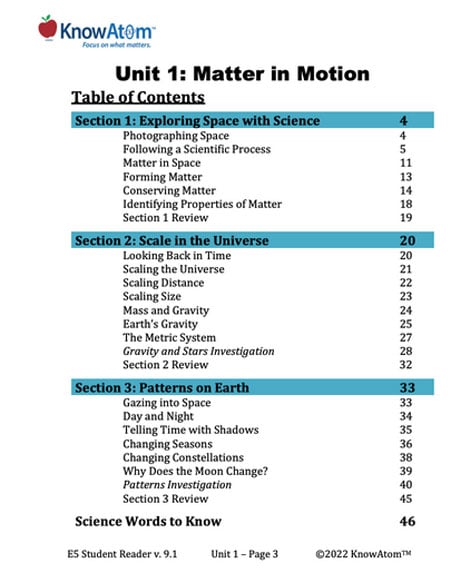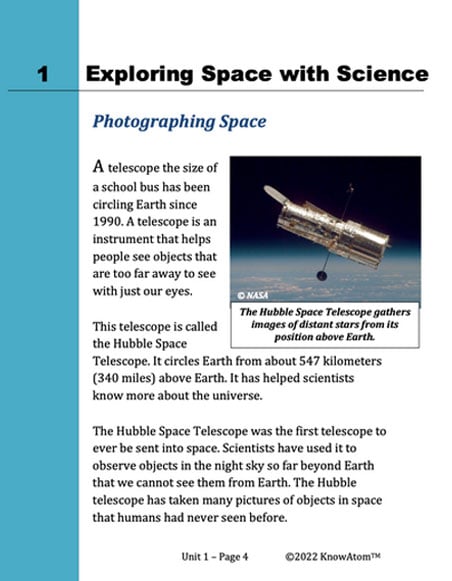Science background gives teachers more in-depth information about the phenomena students explore in this unit on matter. Here is an excerpt from the science background on the Sun Earth Moon system.
All of the planets, stars, and other “stuff” of the universe are made up of atoms and molecules. For example, our Sun is a massive ball made up primarily of the elements hydrogen and helium. It is so massive that more than one million Earths could fit inside it. And yet, amid the estimated 10 sextillion to 1 septillion stars in the universe, our star is just an average-sized star. It seems so much larger and brighter to us than any other star because it is so much closer to Earth than any other star.
The universe is so vast that enormous distances separate matter. The Hubble Space Telescope has taken pictures of some of the most distant galaxies ever seen, including pictures of a galaxy that is 100 million light years away. This is so far away that the images are actually from 100 million years ago, when dinosaurs still roamed Earth. This is possible because the farther away an object is, the longer its light takes to reach you. When you look at an object across the room, you actually see it as it was a few billionths of a second ago.
Because the universe is so immense, scientists often use scale models. Scale models are useful for scientists who want to understand how the various parts of the system interact. Scientists use a scale model to better understand the universe’s structure.
- The Sun is the center of our solar system.
- Our solar system is one of possibly hundreds of billions of solar systems in the Milky Way Galaxy.
- The Milky Way Galaxy is one of about 100 billion galaxies in the known universe.
- All of space is contained in the universe.
Scientists also can use a scale model to represent our solar system. A solar system is a collection of planets and other objects that orbit a star. A planet is a body that orbits (travels in a circle around) the sun, is massive enough for its own gravity to make it round, and has cleared out smaller objects around its orbit. There are eight known planets in our solar system. In 2016, scientists announced that they may have detected a ninth planet, but they haven’t yet confirmed it.
Our sun is much closer to Earth than any other star. In Earth terms, however, it is still very far away. It is 150 million kilometers (93 million miles) away from Earth. At this distance, it takes sunlight eight minutes to travel from the sun’s surface to Earth. Neptune, the farthest planet from the Sun, is 4.5 billion kilometers (2.8 billion miles) from the Sun.
Scale is also important for understanding the relative sizes and masses of different objects in the solar system. The Sun is the most massive object in our solar system. Its diameter is 1.4 million kilometers (865,000 miles) wide. In comparison, Earth’s diameter is 12,742 kilometers (7,918 miles). The planets also differ from each other in size and mass. For example, the four planets closest to the Sun (Mercury, Venus, Earth, and Mars) are much less massive than the four outer planets (Jupiter, Saturn, Uranus, and Neptune).
Another way of understanding these sizes is through an analogy. If the Sun were the size of a typical front door, Earth would be about the size of a nickel. Jupiter, the largest planet in our solar system, would be the size of a basketball. Mercury, the smallest planet, would be the size of a pea.
The Sun is so massive compared to the other objects in our solar system that its gravity holds the entire system in place. Gravity is a force of attraction between all matter. Gravity is what keeps you on Earth. It is also what holds the solar system together. Gravity is a result of an object’s mass. The more massive an object is, the more its gravity will pull on other objects.
The Sun is so massive that its gravity reaches beyond the eight planets of our solar system, pulling every planet toward it. When an object is much more massive than any other object near it, its gravity will pull on the other objects and cause them to move. This gravitational pull is why the planets orbit the Sun.
The force of gravity becomes weaker as the distance between two objects increases. The Sun is much more massive than Earth, but it is also much farther away. This is why here on Earth, you always experience the pull of Earth’s gravity, pulling all objects near Earth’s surface toward the planet’s center. Gravity also determines an object’s weight. Weight is the gravitational force exerted on an object by a planet or moon, and it is measured in newtons (N). Here on Earth, weight is calculated by multiplying the object’s mass by the force of Earth’s gravity.
The pull of Earth’s gravity also keeps our moon in orbit 384,000 kilometers (239,000 miles) above Earth. The Moon orbits Earth for the same reason that the planets orbit the sun. Earth is so massive that its gravity pulls the Moon toward it. The Moon takes about 29.5 days to orbit Earth, which equals one Earth month.
The Moon has a diameter of 3,476 kilometers (2,159 miles). It is about one-quarter the size of Earth. If Earth were the size of a basketball, the moon would be roughly the size of a tennis ball. When astronauts travel to the moon, their mass doesn’t change, but their weight does. This is because the Moon is much less massive than Earth is, so its gravitational force isn’t as strong as Earth’s.










